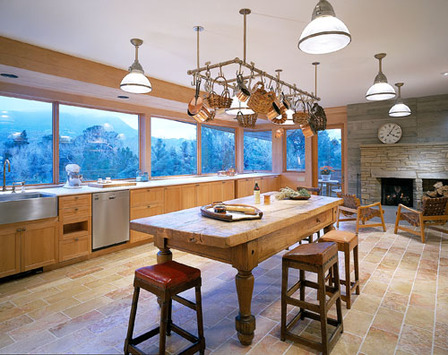Kitchen Lighting Done Right
In planning
your dream kitchen, you probably started with the layout then envisioned where
the major kitchen
appliances will go. You found a place for the refrigerator, the stove, the oven, the microwave and all the smaller appliances
like the blender and waffle maker or George Foreman grill. You have also
probably planned on what material the countertops
will be. Granite or marble? You probably had a long, drawn-out thought about
what you would use as your cabinet’s veneer. Maple and oak both sound equally
appealing. Would they work together?
But how do you plan on seeing what you will be cooking? Proper kitchen lighting is very crucial to the functionality and safety of our kitchens but we often overlook it in the initial design. More often than not, the choice of lighting fixtures and their placements are done as an afterthought – producing less-than-optimal results.
This is unfortunate since the kitchen is the most lived-in part of the home. The term, “living room” is a misnomer because we do most of our living in the kitchen. We eat here, we cook here, homework is done on the kitchen table, and we do out most intimate conversations over dinner. For all intents and purposes, the kitchen is the heart of the home. Because of this, it needs to be versatile. In times of food preparations, you need to be able to see what it is you are doing, but when it’s time to eat, a proper kitchen needs to be able to wind down and get people to relax.
Because of this duality of roles, a kitchen’s lighting needs to be able to adapt. It needs to be as bright as a storefront when work needs to be done, but it has to have to ability to produce a laid-back ambiance that is so conducive to relaxation and quiet conversation.
Achieving both is a hard balancing act, but the potential rewards can be great, so here are a few tips:
· Decide on a interesting lighting fixture and use it as your main overhead light. And instead of going for something that would not look out of place in an operating room, opt for your central light to be soft and not blindingly bright. This will allow you to achieve a warm, calming effect for when you decide to eat casually in the kitchen and not be all “formal” in the dining room. You can then use strategically-placed fluorescent lighting over your countertops and the sink so that you can clearly see what you are doing while food preparations are going on.
· Use dimmer switches. These have been around for decades and you should be using them to adjust the brightness of every room especially in the kitchen. With a dimmer switch in place, you can now decide if you want to the kitchen to be bright or just right.
How an area is lighted dictates how relaxed or alert you will be in it. Unlike most rooms, wherein there is one mood that predominates, the kitchen performs multiple roles throughout the day. Make sure that your kitchen is adaptable with proper kitchen lighting.
But how do you plan on seeing what you will be cooking? Proper kitchen lighting is very crucial to the functionality and safety of our kitchens but we often overlook it in the initial design. More often than not, the choice of lighting fixtures and their placements are done as an afterthought – producing less-than-optimal results.
This is unfortunate since the kitchen is the most lived-in part of the home. The term, “living room” is a misnomer because we do most of our living in the kitchen. We eat here, we cook here, homework is done on the kitchen table, and we do out most intimate conversations over dinner. For all intents and purposes, the kitchen is the heart of the home. Because of this, it needs to be versatile. In times of food preparations, you need to be able to see what it is you are doing, but when it’s time to eat, a proper kitchen needs to be able to wind down and get people to relax.
Because of this duality of roles, a kitchen’s lighting needs to be able to adapt. It needs to be as bright as a storefront when work needs to be done, but it has to have to ability to produce a laid-back ambiance that is so conducive to relaxation and quiet conversation.
Achieving both is a hard balancing act, but the potential rewards can be great, so here are a few tips:
· Decide on a interesting lighting fixture and use it as your main overhead light. And instead of going for something that would not look out of place in an operating room, opt for your central light to be soft and not blindingly bright. This will allow you to achieve a warm, calming effect for when you decide to eat casually in the kitchen and not be all “formal” in the dining room. You can then use strategically-placed fluorescent lighting over your countertops and the sink so that you can clearly see what you are doing while food preparations are going on.
· Use dimmer switches. These have been around for decades and you should be using them to adjust the brightness of every room especially in the kitchen. With a dimmer switch in place, you can now decide if you want to the kitchen to be bright or just right.
How an area is lighted dictates how relaxed or alert you will be in it. Unlike most rooms, wherein there is one mood that predominates, the kitchen performs multiple roles throughout the day. Make sure that your kitchen is adaptable with proper kitchen lighting.

